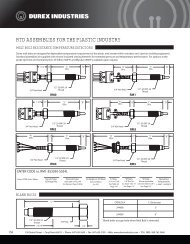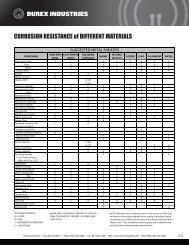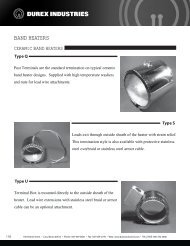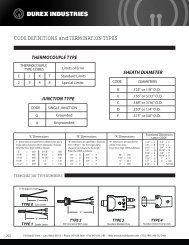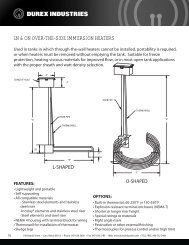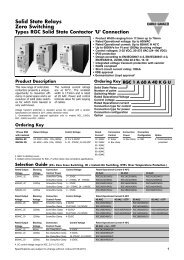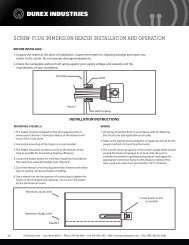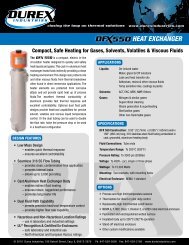Download Full Product Catalog - Durex Industries
Download Full Product Catalog - Durex Industries
Download Full Product Catalog - Durex Industries
Create successful ePaper yourself
Turn your PDF publications into a flip-book with our unique Google optimized e-Paper software.
SILICONE RUBBER HEATERS<br />
MOUNTING OPTIONS<br />
Vulcanizing:<br />
Silicone rubber heaters are most effectively attached to factory surface parts through<br />
vulcanization. Using a heat and pressure process, <strong>Durex</strong> <strong>Industries</strong>’ silicone rubber heaters can<br />
be bonded to a metal surface with no adhesive. The resulting bond is not only strong, but it also<br />
allows excellent heat transfer. This method permits higher watt densities and temperatures than<br />
other methods while still operating safely.<br />
Silicone RTV:<br />
Silicone RTV is a liquid silicone adhesive that can be used to bond silicone rubber heaters to a<br />
surface. It is important that the surface is clean and free from any bumps or grooves to ensure<br />
an even bond. Without an even bond, heat can not be evenly transferred and overheating can<br />
occur. RTV cures at room temperature and requires humidity to cure properly. To guarantee<br />
moisture, place a humidifier near the heater or a moist towel over it if the environment is dry.<br />
Pressure Sensitive Adhesive:<br />
Silicone rubber heaters can also be applied with a pressure sensitive adhesive. First, ensure that<br />
the heater is being applied to a clean surface. The heater should then be rolled in place to<br />
eliminate any air bubbles that would compromise the bond. Large, heavy heaters may not<br />
effectively bond with PSA as their weight can pull them off the surface as temperatures rise.<br />
PSA does have a limited shelf life.<br />
Mechanical Bonding:<br />
If heaters need to be removable, mechanical bonding options may be ideal. These include lacing<br />
eyelets, spring and eyelet combinations, boot hooks, boot type fasteners, snaps, and hook and<br />
loop velcro type fabric straps. Clamps can also be used. The surface must be free of dirt and any<br />
chemicals that might harm the silicone. The surface should also be examined for sharp<br />
protrusions that could pierce the heater. Insulation can be used to direct heat towards the<br />
surface and cushion the heater during compression.<br />
190 Detroit Street • Cary, Illinois 60013 • Phone: 847-639-5600 • Fax: 847-639-2199 • Web: www.durexindustries.com • TOLL FREE: 800-762-3468<br />
137





